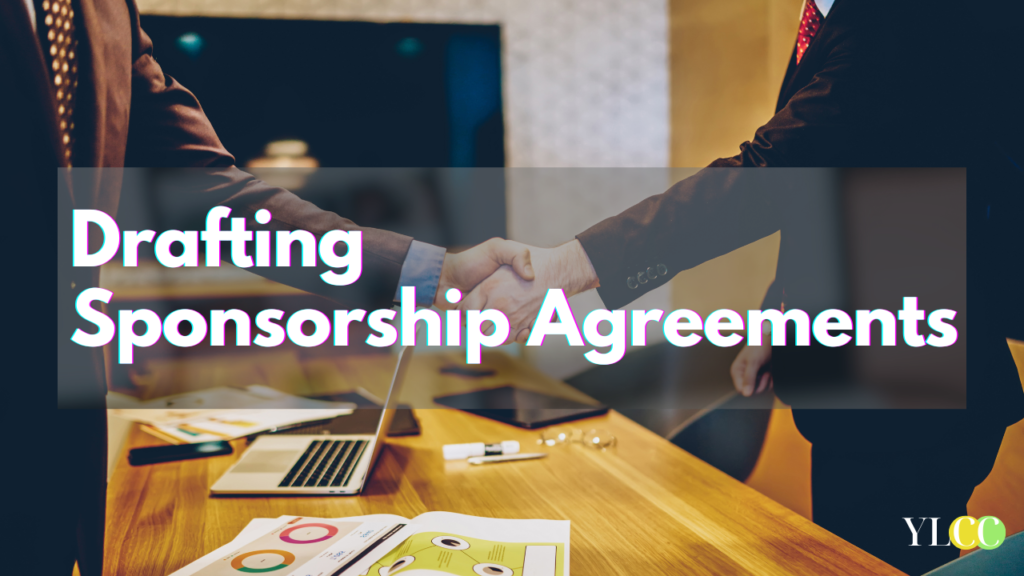
INTRODUCTION
On July 22, 2021 (see here), Tata Consultancy Services entered into an extensive sponsorship agreement with the New York Road Runners. The agreement, spanning eight years, ensures the continuation of TCS’s title and technology sponsorship of the esteemed TCS New York City Marathon until 2029. Moreover, TCS has been making significant strides in the sponsorship realm, as it was announced earlier that the company will take on the role of the new title sponsor for the London Marathon, commencing in 2022.
In today’s competitive business landscape, powerful partnerships have become a strategic imperative for companies aiming to enhance brand awareness and fuel revenue growth. Sponsorship agreements, when executed effectively, can unlock numerous advantages for both parties involved. Not only do they provide financial support for sponsored events or initiatives, but they also offer access to a broader audience and the potential to tap into a sponsor’s established credibility and reputation. Such alliances can propel brands to new heights, leveraging the resources and expertise of sponsors to strengthen market positions and cultivate a devoted customer base.
Throughout this article, team YLCC will explore the elements involved in drafting sponsorship agreements that drive brand awareness and boost revenue. From identifying the ideal partners to negotiating the terms of collaboration, we will uncover key insights and practical strategies for forging fruitful partnerships.
UNDERSTANDING THE VALUE OF SPONSORSHIP AGREEMENTS
Sponsorship agreements serve as formal arrangements between businesses (sponsors) and event organizers, individuals, or organizations (sponsees) to collaborate on specific initiatives or events. These agreements play an effective role in brand promotion and revenue generation, offering a multitude of benefits for both parties involved.
Brand Promotion and Revenue Generation:
Sponsorship agreements act as powerful marketing tools for sponsors, allowing them to associate their brand with high-profile events, causes, or personalities. Sponsors can significantly enhance their brand awareness among the target audience by leveraging the popularity and visibility of the sponsored entity. This increased exposure often translates into higher customer engagement, fostering brand loyalty and, ultimately, boosting revenue streams.

Reasons for Businesses Seeking Sponsorship Deals:
Businesses seek sponsorship deals for a variety of strategic reasons.
Firstly, sponsorship offers a platform to target specific demographics or market segments that align with the sponsor’s target audience and ensures more focused and efficient marketing efforts.
Secondly, sponsoring events or causes that resonate with their brand values helps businesses strengthen their brand identity and reputation.
Moreover, sponsorships facilitate opportunities for product or service showcasing which allows sponsors to engage directly with potential customers and gain valuable feedback. Additionally, these partnerships often provide exclusive access to media exposure, enabling sponsors to reach broader audiences through various marketing channels.
Benefits of Sponsorships Beyond Financial Gains:
While financial returns are a key driver for businesses entering into sponsorship agreements, the benefits extend far beyond monetary considerations.
One significant advantage is the enhancement of brand credibility and perceived goodwill. Sponsors demonstrate their commitment to the community and establish a positive image in the eyes of consumers by associating with reputable events or social causes
Sponsorships also offer valuable opportunities for audience expansion. Sponsors gain access to a broader consumer base and can potentially tap into new markets by aligning with events or entities that have a substantial following. This expansion of the audience reach provides a competitive edge and opens doors for long-term growth.
NEGOTIATING THE SPONSORSHIP AGREEMENT
A successful sponsorship agreement relies on a well-negotiated and mutually beneficial contract that outlines the rights, responsibilities, and expectations of both the sponsor and the sponsee..
Key Elements of a Sponsorship Agreement:
- Duration: Clearly specify the start and end date of the sponsorship arrangement and consider the optimal duration to achieve the desired brand exposure and marketing goals.
- Scope: Outline the specific events, initiatives, or marketing channels covered by the sponsorship and define the roles and responsibilities of each party to avoid misunderstandings.
- Financial Terms: Define the financial commitments, including the sponsorship fee, payment schedule, and any additional costs for activation or promotional materials.
- Exclusivity: Determine if the sponsorship agreement grants exclusivity to the sponsor within the specified industry or market.
- Rights and Obligations: Detail the rights granted to the sponsor, such as logo usage, product placement, and marketing materials. Similarly, outline the obligations of the sponsee regarding brand representation and promotional efforts.
- Termination Clause: Include provisions for early termination and the consequences of breach of contract to protect both parties’ interests.
Effective Negotiation Strategies:
The following are the strategies you can adopt:
- Research and Preparation: Thoroughly research the event or entity being sponsored and understand its audience demographics, reach, and brand alignment. This knowledge will empower the sponsor to negotiate from a position of informed strength.
- Establish Clear Objectives: Both parties should identify their primary goals and expectations from the sponsorship and understand each other’s needs and aligning objectives will lead to more fruitful negotiations.
- Flexibility and Creativity: Be open to exploring creative sponsorship packages and solutions that cater to the specific needs and budget of the sponsor while ensuring the sponsee’s objectives are met.
- Win-Win Approach: Focus on creating a win-win situation for both parties rather than aiming for one-sided benefits. A mutually beneficial partnership is more likely to thrive in the long term.
- Communication and Transparency: Maintain open and honest communication throughout the negotiation process and address concerns, clarify expectations, and ensure all aspects of the agreement are well understood.
- Relationship Building: Invest time in understanding each other’s brand values, culture, and long-term vision because a genuine connection builds trust and paves the way for a fruitful partnership.
- Post-Negotiation Collaboration: The negotiation process is just the beginning. You can collaborate closely during the execution of the sponsorship to ensure its success and address any emerging challenges promptly.
- Evaluation and Improvement: Regularly assess the sponsorship’s performance against the agreed-upon metrics and KPIs and analyze the results and use the insights to refine future sponsorship agreements for even better outcomes.
SUCCESS AND ROI FROM SPONSORSHIP AGREEMENTS
Sponsorship agreements represent significant investments for businesses, making it essential to measure their success and return on investment (ROI) accurately.
Metrics and Key Performance Indicators (KPIs):
- Brand Exposure and Awareness: Measure the reach and frequency of brand mentions, logo visibility, and media coverage generated through the sponsorship. KPIs include impressions, social media mentions, press mentions, and website traffic.
- Audience Engagement: Evaluate the level of audience engagement with the sponsored events or activations. KPIs may include social media interactions, event attendance, and survey feedback from attendees.
- Lead Generation and Conversion: Track the number of leads generated through the sponsorship and assess the conversion rate into actual customers. KPIs include lead capture, website conversions, and sales attributed to the sponsorship.
- Brand Perception and Image: Conduct surveys or analyze sentiment data to gauge any changes in brand perception among the target audience post-sponsorship. Positive shifts in perception indicate successful branding efforts.
- Return on Investment (ROI): Calculate the financial ROI by comparing the sponsorship’s total cost to the direct and indirect financial benefits it generated. This assessment should consider both short-term gains and long-term impacts on revenue and customer retention.
Tracking ROI and Partnership Value:
- Financial Analysis: Assess direct financial gains, such as increased sales, new customer acquisition, and improved profitability, attributed to the sponsorship and consider additional revenue streams like merchandise sales or licensing opportunities resulting from the partnership.
- Cost-Benefit Analysis: Evaluate the sponsorship costs against the KPIs achieved and identify which elements of the sponsorship contributed most to the desired outcomes and adjust future investments accordingly.
- Intangible Benefits: Recognize the value of intangible benefits, such as enhanced brand reputation, improved goodwill, and strengthened customer loyalty. These intangibles can have long-term impacts on a brand’s overall success.
Importance of Post-Event Analysis and Continuous Improvement:
- Post-Event Evaluation: Conduct a thorough post-event analysis to assess the sponsorship’s actual performance against the predetermined objectives and identify successes and areas for improvement, enabling more informed decisions for future sponsorships.
- Learning and Adaptation: Use insights from post-event analysis to refine future sponsorship strategies and adapt sponsorship tactics, target different audiences, or explore new partnership opportunities based on the lessons learned.
- Data-Driven Decision Making: Rely on data and KPIs to make informed decisions about future sponsorships. This ensures that investments align with the business’s goals and provide measurable value.
- Long-Term Partnerships: Nurture strong relationships with successful sponsors for continued collaboration and mutual benefits. Long-term partnerships can lead to better understanding, streamlined activations, and greater returns over time.
CONCLUSION
A well-negotiated sponsorship agreement plays a significant role in brand promotion and revenue generation. Businesses can harness the full potential of sponsorships to expand their reach and connect with their target audience on a deeper level by aligning with the right partners and specifying the duration, scope, financial terms, and exclusivity,
Well-drafted sponsorship agreements hold the key to powerful collaborations that elevate brands to new heights. Businesses can strengthen their market presence, cultivate loyal customer bases, and ultimately boost revenue by capitalizing on these opportunities. The future of sponsorship agreements lies in their adaptability and ability to align with changing consumer preferences and emerging trends. Embracing dynamic sponsorship strategies will enable businesses to stay ahead in a highly competitive landscape and solidify their positions as industry leaders. As we move forward, the successful integration of sponsorship agreements will continue to shape the success stories of businesses!
Disclaimer: This article is for information purposes only. You are advised to consult a legal professional for drafting such crucial documents for your business.
This article has been written by Team YLCC. For any other queries, reach out to us at: queries.ylcc@gmail.com




